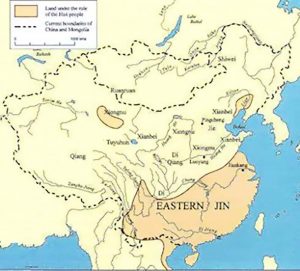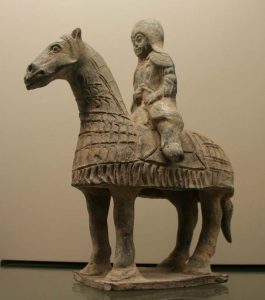The Period of Division, 220 – 589 CE
Like these other empires, the Han Dynasty also eventually fell. China was then divided up by independent, short-lived kingdoms until 589 CE, when the Sui Dynasty reunited most of the territory once controlled by the Han. Thus, for four centuries, during what is known as the Period of Division, China was politically unstable and racked by endemic warfare. Yet, in spite of the violence, these centuries also saw vibrant cultural developments, as Buddhism became an organized institutional religion reshaping the spiritual landscape.
Political History–From Three Kingdoms (220 – 280) and the Western Jin (265 – 317) to the Northern and Southern Dynasties (317 – 589)
During the second century CE, a combination of factors led to massive rebellions against the Han Dynasty by lower classes living in the countryside. Many once thriving, independent farmers who fell on hard times lost their land to powerful local families who used their political connections to amass large estates. A series of floods and droughts and the famines and epidemics they caused only worsened these farmers’ plight, and the government was ineffective in providing relief. During the later Han, government revenue had fallen because local magnates kept their growing estates off the tax rolls. Also, many later Liu emperors were mere youths dominated by quarreling factions of imperial in-laws and eunuchs, so the quality of governing declined.
Desperate to escape poverty and starvation, many villagers fled their homes or joined roving bandit gangs. Some rallied behind individuals who promised the dawn of a new age, thereby becoming part of large, militarized religious societies with political goals. One was the Yellow Turbans, a society named after the yellow cloth members wrapped around their heads. The founder, Zhang Jue [jawng joo-eh], claimed he was a devoted follower of the legendary Daoist philosopher Laozi, who had by this time been deified and envisioned living ina Daoist heaven. Zhang accrued a following of disciples by instructing them in faith healing, establishing a rudimentary organization, and prophesying an impending apocalypse. He led his followers to believe that the apocalypse would be followed by an age of peace when the sky would turn yellow and all would be equal. The movement grew into the tens of thousands. Some followers proclaimed 184 CE was propitious, daubing the characters for that year in mud on the gates to government offices. The Yellow Turbans rebelled, and unrest spread across north China. Other similar millenarian religious movements followed.
The Han Dynasty was in crisis but lacked the strong leadership of earlier rulers like the founder Liu Bang or Emperor Wu. Youthful emperors were forced to rely on generals who commanded permanent standing armies around the empire as if they were private possessions. But by empowering military strongmen to suppress rebellions, Han rulers sealed the fate of the dynasty. Generals feuded amongst each other and competed to impose a military dictatorship on the court. Eventually, in 220 CE, one general deposed the Han emperor, but he failed to unite the realm because by that time the country had been divided up by three kingdoms and their rival warlords.
Within their realms, each warlord sought to strengthen his hand against the others by restoring order and establishing a functioning state. After all, they needed fighting men and revenue. Cao Cao (155 – 220 CE) was the most effective in achieving these goals. He was the adopted son of a Han court eunuch and eventually entered the military. As a commander, he earned his spurs leading Han armies against the Yellow Turbans. As the dynasty fell apart, he gained control over it and established a dictatorship in northern China. It was his son who removed the last Han ruler and established the Wei [way] Dynasty (220 – 265 AD), one of the Three Kingdoms (see Map 4.12).

By this time, as a result of the rebellions and civil wars, much land in north China had gone to waste. So Cao Cao turned it into huge state farms where he could settle his soldiers, landless poor, and, most importantly, tribes of nomadic herders from the steppe lands to the far north who had served him as he came to power. Thus, Cao rulers created colonies of farmers who supplied tax revenue and, as hereditary military families, soldiers for Wei armies. Such stateowned land and hereditary soldiers became the mainstays of warlord dynasties throughout this time. The two other kingdoms, Wu and Han, were located in the south. Over the course of decades, the ruling warlords of all three states fought each other in campaigns involving much treachery and stratagem. In 263 CE, the Han kingdom fell to the invading forces of Wei commanders. But then, just two years later, a powerful Wei family–the Sima– usurped the throne and changed the kingdom’s name to Western Jin [jean] (265 – 317 CE). The Western Jin conquered Wu in 280 BCE, thereby bringing to an end the Three Kingdoms period.
The Western Jin had reunified China, but that unity wasn’t to last. The policy of settling tribes of non-Chinese nomads in north China backfired. Among them, rebel chieftains rose up, carved out kingdoms of their own, and expanded their power all across the north. One Xiongnu chieftain, Liu Yuan [lee-oh you-anne], even declared he was a descendant of a Han Dynasty imperial princess and therefore had the right to restore the Han Empire. His son descended on the Western Jin court at Luoyang and eventually, in 317 CE, forced it to flee east to Jiankang [jeean cawng] (today’s city of Nanjing).

China was again divided up among competing dynasties, a state of affairs that would persist until 589 CE, during a time referred to as the Northern and Southern Dynasties (317 – 589). Six successive Southern Dynasties were all located at Jiankang, and had as their base of power the Yangzi River basin (see Map 4.13). But their rulers were usually militarily weak and lacked revenue, due to southern China’s comprising a colonial frontier dominated by powerful families with large estates and private armies. These families highly valued their pedigrees, intermarried, and saw themselves as the heirs to Confucian civilization. At the southern court, they dominated high offices, thus constituting a hereditary aristocracy. The ruling family was always limited in power by their influence.
The situation was even more complex in the north during those three centuries. The kingdom established by Liu Yuan along the Yellow River was just one of numerous short-lived Northern Dynasties established by non-Chinese chieftains of different ethnicities. The Liu rulers, for instance, were Xiongnu, while others were of Turkic ancestry. At times, the north was divided among numerous, rival regimes, while, at others, it was unified. But all of these kingdoms shared similar characteristics. They were ruled by military dynasts who wanted to restore the Chinese empire. Their armies consisted of an elite, heavily armored cavalry drawn from aristocratic military families that was supplemented by Chinese foot soldiers (see Figure 4.13). They employed educated Chinese to serve as civil officials and administer their territories.
The Northern and Southern Dynasties came to an end in 589 CE after Yang Jian [yawng geean], a general hailing from the ruling clan of a northern kingdom, first established control over all of north China and then defeated the last southern dynasty. He ruled his new Sui [sway] Dynasty as Emperor Wen [one]. China was once again united under one dynasty (see Map 4.14).
China’s Third Great Tradition: The Introduction of Buddhism to China
Aside from the shifting configuration of kingdoms, perhaps the most notable development during the Period of Division was the introduction of Mahayana (“Great Vehicle”) Buddhism into China (for the development of Mahayana Buddhism, see Chapter Three). Beginning from the second century CE, at the end of the Han Dynasty, Buddhist merchants and monks from India and Central Asia brought their faith and scriptures to China by the Silk Roads and maritime trading routes (see Map 4.15). The impact was immense and can be compared to the Christianization of the Mediterranean region and spread of devotional forms of Hinduism in South Asia during this same period of time (see Chapters Three and Six). Historians estimated that by the time the Sui Dynasty reunited China four centuries later, China had approximately 33,000 Buddhist temples and two million monks and nuns. Buddhism had become a large-scale religious organization with these temples, clerics, and scriptures (see Figure 4.14), as well as a widespread popular faith capturing the imagination of common people and rulers alike.
Historians have also hypothesized why this spread occurred. First of all, Buddhism clearly met a spiritual need. During the Period of Division, turmoil from rapid political change and constant warfare brought much suffering and instability to people’s lives. Now, here was a religion that explained their suffering with notions of karma and rebirth and also offered hope with paths to salvation and enlightenment. Buddhism placed the world amidst visions of multiple hells and heavens where merciful Buddhas and Bodhisattvas worked for the salvation of all beings.
Buddhism appealed to people in different ways. For scholarly elites living in capital cities or as hermits in mountain retreats, Buddhist doctrines about the nature of reality, self, and enlightenment were appealing because they seemed similar to concepts in Daoist philosophy. Both philosophies questioned the reality of ordinary understandings of the self and world, emphasized that our desires create an illusory world, and offered techniques for achieving liberation. Nirvana, for instance, was compared to the Dao (Daoist “Way”).
For rulers, Buddhism served political purposes. Since the faith became so popular, rulers who took vows and sponsored temple construction and the ordination of monks looked good because they were upholding the dharma, that is, the Buddhist law. Some even went so far as to have monks recognize them as incarnate Buddhas. Lastly, Buddhist monks–whether foreign or Chinese–were some of the most educated people at their courts and could assist rulers with mundane matters, like international relations, but also esoteric ones, such as spells and divination. Monks won support by promising that their rituals and incantations had magical potency.
Lastly, for most people, Buddhism was a devotional religion. Buddhas and Bodhisattvas were merciful beings to be worshipped because their good karma redounded to the benefit of all beings. By going to a temple and burning incense or praying and making offerings before a Buddha statue, the faithful might have a simple wish granted: an illness cured, loved ones helped, or a better rebirth ensured.

